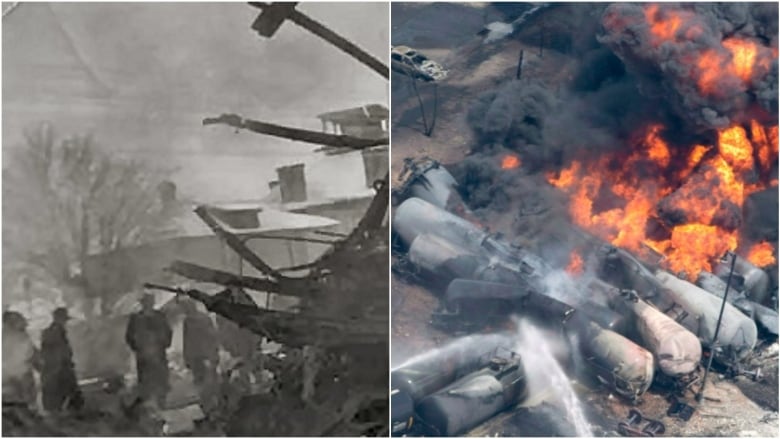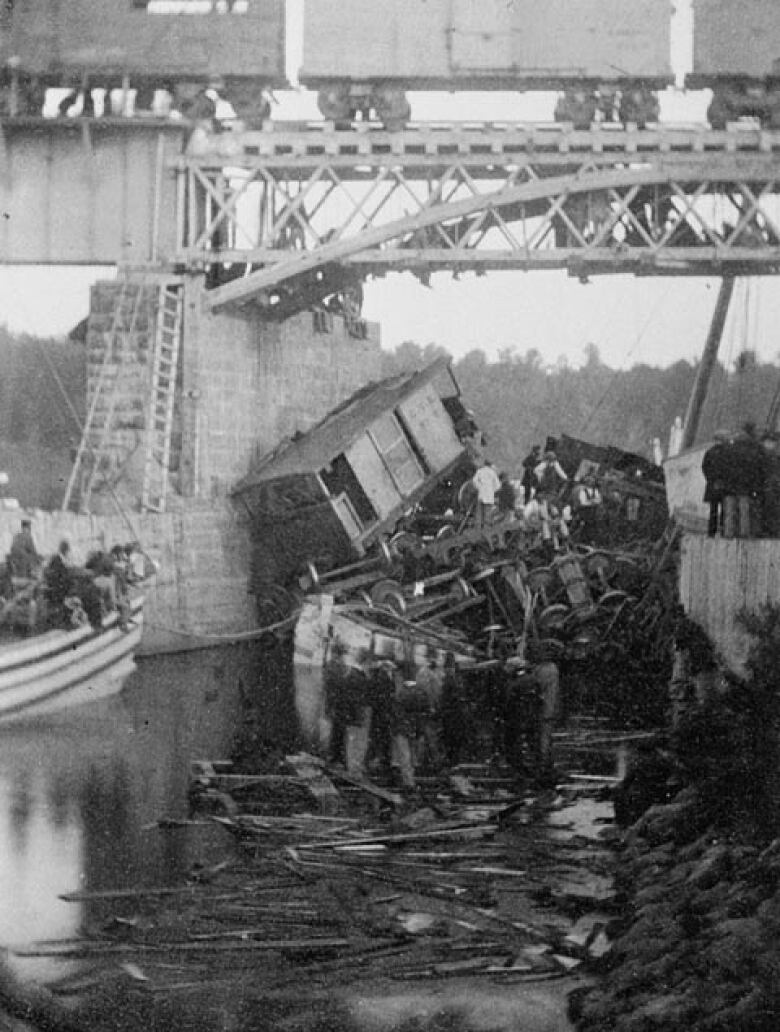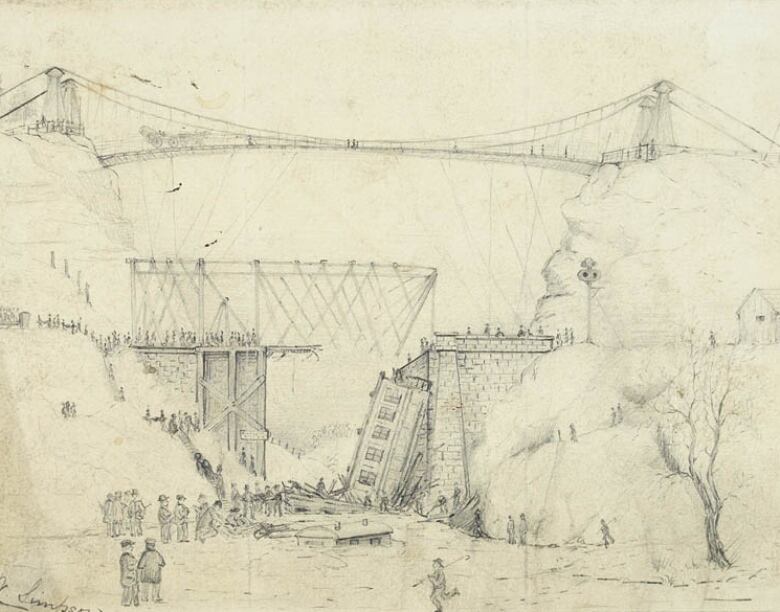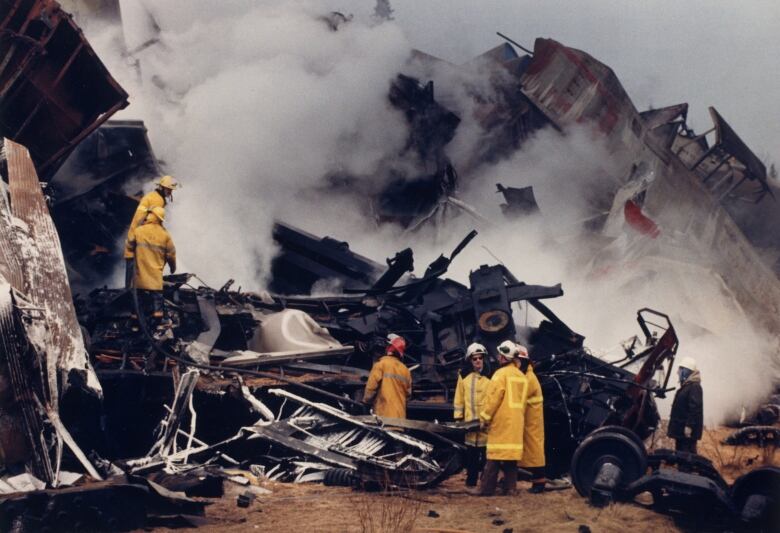From 99 dead when train plunged through swing bridge to Lac-Mgantic: Canada's most deadly rail accidents
Canada's worst rail disaster killed 99 people at Saint-Hilaire, Que., in 1864

As investigators work to determine all of the contributing factors in the Canadian Pacific freight train derailment that took the lives of three crew members Monday near Field, B.C.,here's a look back at some of Canada's worst rail accidents.
1. Saint-Hilaire, Que. |June 29, 1864 |99 dead
Human error causedCanada's deadliest rail disaster, which left 99 deadwhen aGrand Trunk Railway train plunged into the gap of a swing bridge over the Richelieu River on June 29, 1864. The red light signalling for the train to stop wasn't seen by either the conductor or the engineer. The train was full of German and Polish immigrants, as rail cars piled one on top of the other.

2. Desjardins Canal, Ont. |March 12, 1857 |59 dead
An axle of a train headed to Hamilton from Toronto broke as it crossed the Desjardins Canal Bridge on March 12, 1857. The train left the tracks, crashing 18 metres tothe freezing water below and killing 59 people. A public funeral drew 10,000 people.

3. Baptiste Creek, near Chatham, Ont. |Oct. 27, 1854 |52 dead
Several factors led to the collision of a gravel train and an express train that was running late, which resulted in 48 people injured and 52 dead on Oct. 27, 1854 at the time, the worst rail crash in North America. It happened near Chatham, Ont., in an area known today as Jeannette's Creek.
4. Lac-Mgantic, Que. |July 6, 2013 |47 dead
On July 6, 2013, 47 people died when a freight train loaded with 7.7 million litres of fuel rolled unmanned into the downtown core of Lac-Mgantic, Que., and explodedin the middle of the night.A Transportation Safety Board of Canada (TSB) found 18 factors in the crash that killed the victims, who rangedin age from four to 93. Among the factors, theTSBfound an insufficient number of hand brakes had been applied.Transport Canada then toughened its standards, requiringcompanies to havemore substantial"physical defences to prevent runaway equipment."
5. West of Sudbury, Ont. |Jan. 21, 1910 |43 dead
A passenger train left the tracks near the crossing west of Sudbury, at the Spanish River on Jan. 21, 1910. The first two rail cars fell into the freezing river below, killing 43 people. Speed and a brokenrail were considered factors.
6. Almonte, Ont. |Dec. 27, 1942 |39 dead
During the Second World War, atrain carrying troops from Alberta crashed into a passenger train sitting in the station in Almonte, Ont., on Dec. 27, 1942, injuring more than 200 people and killing 39. The passenger train was running behind schedule, with railway staff blaming the delay on stormy weather, icy tracks, a downgraded line and the congestion of holiday traffic. The conductor of the troop-laden train later killed himself.
7. Dugald, Man. |Sept. 1, 1947 |31 dead
A passenger train headed west failed to turn into a siding and crashed into an eastbound train in Dugald, Man.,on Sept. 1, 1947. Wooden passenger cars were kept in service due to steel rationing during the Second World War and the fire was fed by thewood and the old cars' gas illumination. The crash and fire killed 31 people.Newer, safer railway cars were ordered as a result of the crash.
8. Wanstead, Ont. |Dec. 27. 1902 |31 dead
A westbound express train headed to Sarnia, Ont., from Londonincreased its speed near the Wanstead station, colliding with a slow-moving eastbound freight train that had been trying to get out of the way. It left31 dead. Weather conditions on Dec. 27, 1902, had reduced visibility so the two trains couldn't see each otheruntil it was too late.
9. Hinton, Alta. |Feb. 8, 1986| 23 dead
A freight train collided with a passenger train between Jasper and Edmonton, leaving 95 injured and 23 dead on Feb. 8, 1986. An inquiry found the crew ignored stop signals and failed to follow established operating rules, while demonstrating a lack of awareness.

10. Canoe River, B.C. |Nov. 21, 1950 |21 dead
On Nov. 21, 1950, a train carrying troops for the Korean War crashed with a second train after railway telegraph operator Jack Atherton sent an incomplete message regarding the location of one of the trains. The crash led to the death of 17 soldiers and four crew members. Defended by John Diefenbaker(who practised criminal lawbefore becoming Canadian prime minister from 1957 to 1963), Atherton was found not guilty.

- TSB says train began to move on its own before fatal derailment near Field, B.C.
- 'Half of me is gone': Twin of CP Rail victim mourns loss of brother, colleagues
- Read more articles by CBC Calgary, like us on Facebook for updates and subscribe to our CBC Calgary newsletter for the day's news at a glance.
With files from CBC Archives, the Passionate Eye













_(720p).jpg)


 OFFICIAL HD MUSIC VIDEO.jpg)
.jpg)



























































































